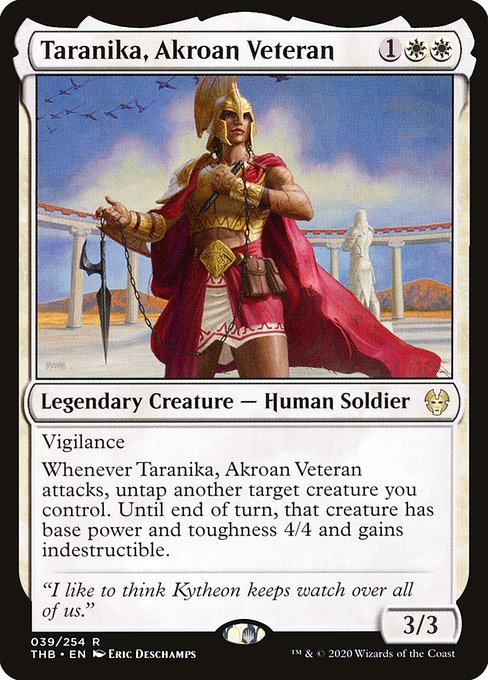
Image courtesy of Scryfall.com
Machine-Learning Commander Deck Optimization for Taranika, Akroan Veteran
Deckbuilding in the Commander format is as much art as science, and that’s where machine learning can become your co-pilot. Taranika, Akroan Veteran—a white, vigilance-wielding legendary Human Soldier from Theros Beyond Death—presents a delightful sandbox for applied optimization. With a cost of {1}{W}{W}, a sturdy 3/3 body, and a toolkit that rewards aggressive, resilient combat, this commander invites a design space where every attack becomes a probability experiment: which creature to untap, which buff to apply, and how to sustain pressure while remaining defensible. 🧙♂️🔥
On the surface, Taranika’s ability is elegant but powerful: when she attacks, you untap another target creature you control, and that creature becomes a 4/4 indestructible for the turn. Vigilance lets you keep the battlefield posture intact, so you can press for damage while staying ready for blockers. It’s the kind of effect that rewards careful sequencing—timing your untaps, stacking damage, and punishing planeswalkers who overextend. The flavor text—“I like to think Kytheon keeps watch over all of us.”—keeps the flame of myth alive while you plan your next swing. This delicate dance between offense and survivability is exactly where data-driven brew helps, turning intuition into repeatable turns. ⚔️
Enter machine learning. The idea is simple in theory: give a model a rich representation of each card (mana cost, color identity, creature type, power/toughness, keywords like vigilance or indestructible, rarity, and synergy signals such as “untap,” “combat tricks,” or “protective buffs”). Then train on a corpus of historical Commander decks and match results to learn which cards tend to harmonize with a given commander’s signature mechanics. For Taranika, the model would reward cards that amplify combat efficiency without bloating mana curves, and it would favor options that enable explosive turns where you untap a pivotal creature for a 4/4 indestructible surprise. The model also considers constraints like color identity (White), legal formats (Commander and a broad family of eternal formats), and the rhythm of a white-based deck: board presence, protection, inevitability, and value engines. 🧠💡
From a practical standpoint, you can build a lightweight feature set that a deck optimizer would weigh. Here are the categories that tend to rise to the top for a Taranika shell:
- Untap enablers: cards that reliably untap a creature you control during or after combat—opening the door to multiple triggers and reapplying pressure in a single turn.
- Protective combat tricks: effects that grant indestructibility or damage mitigation for key attackers to survive a board wipe or a mass-removal spell.
- Vigilance-friendly bodies: threats that can swing and stay ready to defend, preserving your positional advantage even when resources dwindle.
- Card advantage & filtering: efficient draw and filtering that ensures your white beats don’t stall out the turn after the big swing.
- Lifegain and resilience: to weather stalls and keep you in the game as you sculpt a longer game plan around Taranika’s power.
Of course, the real juice comes from the evaluation loop. A learning-based approach can simulate many turns of gameplay, testing whether a given card combination actually increases win probability under typical metagame conditions. The model might run thousands of simulated games, adjusting weights for synergy with Taranika’s tapping tempo, evaluating how often untap turns translate into lethal swings, and measuring the reliability of indestructible windows in real-world play. The result isn’t a single “best card” but a ranked spectrum of candidates aligned with your deck’s goals. And if your meta shifts—say, more wipe-heavy tables or more stasis-control—your ML-guided list can adapt with a fresh export. 🧭🎲
When you’re ready to craft a concrete blueprint, think about a lean white shell that leans on a few evergreen pillars. Start with Taranika at the center, then anchor the board with a handful of resilient, high-clarity threats and supportive creatures that tolerate mass removal. A core that emphasizes tempo and inevitability pairs well with neat untap toys and buff enablers. The number one principle is balance: you want enough creatures to exploit the untap trigger without tipping into a crowded battlefield that surrenders card advantage to your opponents’ removal. The magic lies in how you thread the needle—turn after turn, attack after attack, finding that sweet spot where every decision is one good draw away from a devastating sequence. 🧙♂️
For players who enjoy the creative process of cross-pollinating decks with themes, there’s a moment of nostalgia in playing a white weenie/voltron hybrid that can still deliver a big punch. Taranika’s toolkit invites you to imagine a world where a single well-timed untap—and a couple of careful buffs—can transform a humble 2/2 or 3/2 into a siege engine that endures the heat of combat. The synergy is elegant and tactile: you attack, you untap, you buff, and you swing again with a creature that’s now 4/4 and indestructible for the turn. The result is a tactile jolt of strategy that never feels stale, a meeting point of classic white resilience and modern optimization tricks. ⚔️💎
And while you’re brewing, a little real-world gear can keep the vibe polished. If you’re matching this theme to a casual, stylish setup, consider the Blue Abstract Dot Pattern Tough Phone Case by Case Mate—it’s a subtle nod to the neat, geometric energy of a well-ordered deck. A good case makes your device as resilient as your creatures, a small thrill in a long day of brewing and playtesting. You can grab it here:
Blue Abstract Dot Pattern Tough Phone Cases Case Mate
More from our network
- https://articles.digital-vault.xyz/blog/post/top-company-of-heroes-3-fan-theories-that-might-be-true/
- https://crypto-acolytes.xyz/blog/post/what-makes-streaming-horror-so-addictive-for-viewers/
- https://blog.digital-vault.xyz/blog/post/disease-carriers-assessing-long-term-value-in-mtg-finance/
- https://crypto-acolytes.xyz/blog/post/latest-pc-game-crowdfunding-trends-and-backer-insights/
- https://blog.rusty-articles.xyz/blog/post/tracking-poultice-slivers-meta-stability-across-sets/